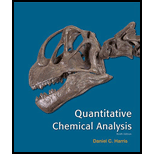
a)
Interpretation:
The enthalpy of vaporization of Octane has to be calculated.
Concept Introduction:
The Trouton’s rule for non-bonding Hydrogen solutes states that the heat of vaporization is directly proportional to the boiling temperature.
The enthalpy of vaporization can be calculated as,
To calculate the enthalpy of vaporization of Octane
a)
Answer to Problem 24.19P
The enthalpy of vaporization of Octane is
Explanation of Solution
Given,
Boiling point of Octane =
Boiling point =
Boiling point =
The enthalpy of vaporization of Octane is calculated as,
The enthalpy of vaporization of Octane =
b)
Interpretation:
The vapour pressure of Octane has to be calculated.
Concept Introduction:
The vapour pressure of compound can be related to heat of vaporization
Here,
To calculate the vapour pressure of Octane
b)
Answer to Problem 24.19P
The vapour pressure of Octane is
Explanation of Solution
Given,
The vapour pressure of Octane =
c)
Interpretation:
The vapour pressure of Hexane has to be calculated.
Concept Introduction:
The vapour pressure of compound can be related to heat of vaporization
Here,
To calculate the vapour pressure of Hexane
c)
Answer to Problem 24.19P
The vapour pressure of Hexane is
Explanation of Solution
The vapour pressure of Hexane =
d)
Interpretation:
The relationship between vapour pressure of solute and retention has to be given.
To give the relationship between vapour pressure of solute and retention
d)
Explanation of Solution
The vapour pressure of solute and the retention are inversely proportional to each other.
If the vapour pressure would be lower, then the retention would be greater.
e)
Interpretation:
The reason has to be explained for the name of technique as “gas chromatography” if the analytes retained are partially vaporized.
To explain why the technique is called as “gas chromatography” if the analytes retained are partially vaporized
e)
Explanation of Solution
When the analytes retained are partially vaporized, the technique is called as gas chromatography since the mobile phase would be gaseous in form.
Want to see more full solutions like this?
Chapter 24 Solutions
Solution Manual for Quantitative Chemical Analysis
- The temperature on a sample of pure X held at 1.25 atm and -54. °C is increased until the sample boils. The temperature is then held constant and the pressure is decreased by 0.42 atm. On the phase diagram below draw a path that shows this set of changes. pressure (atm) 2 0 0 200 400 temperature (K) Xarrow_forwardQUESTION: Answer Question 5: 'Calculating standard error of regression' STEP 1 by filling in all the empty green boxes *The values are all provided in the photo attached*arrow_forwardpressure (atm) 3 The pressure on a sample of pure X held at 47. °C and 0.88 atm is increased until the sample condenses. The pressure is then held constant and the temperature is decreased by 82. °C. On the phase diagram below draw a path that shows this set of changes. 0 0 200 temperature (K) 400 аarrow_forward
- er your payment details | bar xb Home | bartleby x + aleksogi/x/isl.exe/1o u-lgNskr7j8P3jH-1Qs_pBanHhviTCeeBZbufuBYT0Hz7m7D3ZcW81NC1d8Kzb4srFik1OUFhKMUXzhGpw7k1 O States of Matter Sketching a described thermodynamic change on a phase diagram 0/5 The pressure on a sample of pure X held at 47. °C and 0.88 atm is increased until the sample condenses. The pressure is then held constant and the temperature is decreased by 82. °C. On the phase diagram below draw a path that shows this set of changes. pressure (atm) 1 3- 0- 0 200 Explanation Check temperature (K) 400 X Q Search L G 2025 McGraw Hill LLC. All Rights Reserved Terms of Use Privacy Cearrow_forward5.arrow_forward6.arrow_forward
- 0/5 alekscgi/x/sl.exe/1o_u-IgNglkr7j8P3jH-IQs_pBaHhvlTCeeBZbufuBYTi0Hz7m7D3ZcSLEFovsXaorzoFtUs | AbtAURtkqzol 1HRAS286, O States of Matter Sketching a described thermodynamic change on a phase diagram The pressure on a sample of pure X held at 47. °C and 0.88 atm is increased until the sample condenses. The pressure is then held constant and the temperature is decreased by 82. °C. On the phase diagram below draw a path that shows this set of changes. 3 pressure (atm) + 0- 0 5+ 200 temperature (K) 400 Explanation Check X 0+ F3 F4 F5 F6 F7 S 2025 McGraw Hill LLC All Rights Reserved. Terms of Use Privacy Center Accessibility Q Search LUCR + F8 F9 F10 F11 F12 * % & ( 5 6 7 8 9 Y'S Dele Insert PrtSc + Backsarrow_forward5.arrow_forward9arrow_forward
 ChemistryChemistryISBN:9781305957404Author:Steven S. Zumdahl, Susan A. Zumdahl, Donald J. DeCostePublisher:Cengage Learning
ChemistryChemistryISBN:9781305957404Author:Steven S. Zumdahl, Susan A. Zumdahl, Donald J. DeCostePublisher:Cengage Learning ChemistryChemistryISBN:9781259911156Author:Raymond Chang Dr., Jason Overby ProfessorPublisher:McGraw-Hill Education
ChemistryChemistryISBN:9781259911156Author:Raymond Chang Dr., Jason Overby ProfessorPublisher:McGraw-Hill Education Principles of Instrumental AnalysisChemistryISBN:9781305577213Author:Douglas A. Skoog, F. James Holler, Stanley R. CrouchPublisher:Cengage Learning
Principles of Instrumental AnalysisChemistryISBN:9781305577213Author:Douglas A. Skoog, F. James Holler, Stanley R. CrouchPublisher:Cengage Learning Organic ChemistryChemistryISBN:9780078021558Author:Janice Gorzynski Smith Dr.Publisher:McGraw-Hill Education
Organic ChemistryChemistryISBN:9780078021558Author:Janice Gorzynski Smith Dr.Publisher:McGraw-Hill Education Chemistry: Principles and ReactionsChemistryISBN:9781305079373Author:William L. Masterton, Cecile N. HurleyPublisher:Cengage Learning
Chemistry: Principles and ReactionsChemistryISBN:9781305079373Author:William L. Masterton, Cecile N. HurleyPublisher:Cengage Learning Elementary Principles of Chemical Processes, Bind...ChemistryISBN:9781118431221Author:Richard M. Felder, Ronald W. Rousseau, Lisa G. BullardPublisher:WILEY
Elementary Principles of Chemical Processes, Bind...ChemistryISBN:9781118431221Author:Richard M. Felder, Ronald W. Rousseau, Lisa G. BullardPublisher:WILEY





